What is an Inverter?
An inverter (or power inverter) is a power electronics device which used to convert the DC voltage into AC voltage. Although DC power is used in small electrical gadgets, most household equipment runs on AC power. Therefore, we need to convert DC power into AC power.
The inverter is a static device. It can convert one form of electrical power into other forms of electrical power. But it cannot generate electrical power. Hence the inverter is a converter, not a generator.
It can be used as a standalone device such as solar power or back power for home appliances. The inverter takes DC power from the batteries and converts into AC power at the time of the power failure.
A power inverter used in the power system network to convert bulk DC power to AC power. i.e. It used at the receiving end of HVDC transmission lines. This inverter is known as a grid-tie inverter.
How Does an Inverter Work?
Let’s understand the working of an inverter by an example. One bulb connected with a battery. It makes a close path. Hence the current will flow through the bulb.
The bulb has two terminals that are ‘A’ and ‘B’. The positive and negative terminal of the battery is connected with ‘A’ and ‘B’ terminal respectively and the bulb will glow.
Now, change the terminals of the battery. The bulb will glow in this condition also. So, what is the difference in both cases?
Here, one thing is different and that is the direction of the AC current.
Now imagine that you can rotate the battery at 50 or 60 rpm. What will happen? The direction will change 50 or 60 times. This is similar to AC power. And the frequency is 50 or 60 Hz.
This is just to understand the working principle of an inverter. Practically, inverter never works like this and it doesn’t have rotating parts.
The inverter uses the power electronics switches like IGBT, MOSFET. The number of switches depends on the type of inverter.
Let’s take a circuit diagram of a single-phase full-bridge inverter to understand the working.
This article on power inverters has been reproduced from Electrical4U










